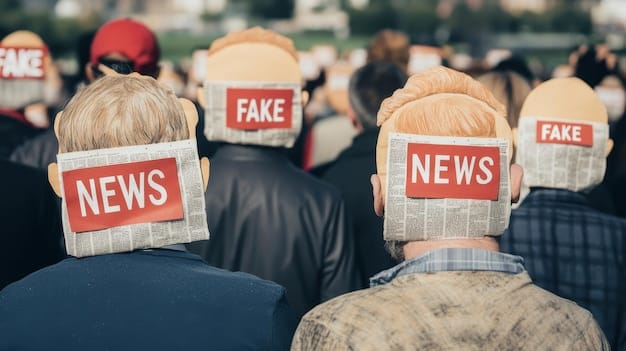How to Spot Fake News on TV: A Guide to Identifying Misleading Reporting

Spotting fake news on TV involves verifying sources, scrutinizing the information presented, and being aware of manipulative techniques often used in misleading reporting.
In today’s media landscape, discerning fact from fiction on television has become increasingly challenging. This guide will equip you with essential tools to spot fake news on TV: a guide to identifying misleading reporting and ensuring you’re consuming trustworthy information.
Understanding Fake News on TV
Fake news on TV isn’t always obvious. It ranges from subtle misinformation to outright fabrication, often designed to influence opinions or drive viewership. Understanding the different forms it takes is the first step in protecting yourself from its harmful effects.
Types of Misleading Information
Being able to identify the different types of misleading information is crucial. Here are a few common forms you might encounter on TV:
- Satire or Parody: While often humorous, it can be mistaken for genuine news if not clearly identified.
- Misleading Headlines: Sensationalized or clickbait headlines that distort the content of the story.
- False Context: Presenting genuine information in a way that distorts its meaning.
Motives Behind Fake News
Fake news isn’t always accidental. Understanding the motives behind its creation can help you approach news with a critical eye:
- Political Agendas: To discredit political opponents or sway public opinion.
- Financial Gain: To generate clicks and advertising revenue through sensational or outrageous stories.
- Social Disruption: To sow discord and division within communities.
By understanding the motives and forms of fake news, you can better equip yourself to identify and avoid it. Always question the source, consider the context, and seek verification from multiple reputable sources.

Verifying Sources and Information
One of the most effective strategies for spotting fake news is to meticulously verify the sources and information presented. Credible news outlets adhere to journalistic standards, including fact-checking and providing verifiable sources.
Checking the Credibility of News Outlets
Not all news outlets are created equal. Here’s how to assess the credibility of a news source:
- Reputation: Research the outlet’s history and reputation for accuracy and impartiality.
- Editorial Standards: Look for clear editorial policies and fact-checking processes.
- Contact Information: A legitimate news outlet will have readily available contact information.
Fact-Checking Techniques
Even with a credible source, it’s wise to employ fact-checking techniques to confirm the accuracy of the information presented:
- Cross-Reference: Compare the information with reports from other reputable news sources.
- Consult Fact-Checking Websites: Utilize resources like Snopes, PolitiFact, and FactCheck.org.
- Verify Quotes and Data: Ensure that quotes are accurately attributed and data is properly sourced.
Employing these verification techniques can significantly reduce your exposure to fake news. By staying informed and critically evaluating the information you consume, you can become a more discerning news consumer.
Analyzing the Visuals and Presentation
TV news relies heavily on visuals and presentation techniques, which can sometimes be used to manipulate viewers. Paying close attention to these elements is essential for detecting misleading reporting.
Identifying Manipulative Visuals
Visuals can be powerful tools for persuasion. Be wary of the following:
- Emotionally Charged Images: Images designed to evoke strong emotions, such as fear or anger.
- Out-of-Context Footage: Using footage from one event to represent another.
- Doctored Images and Videos: Manipulated images or videos that distort reality.
Recognizing Bias in Presentation
Bias can creep into news presentation in subtle ways. Watch out for these indicators:
- Tone and Language: Biased language or tone that favors one side of an issue.
- Selective Editing: Editing that presents only one perspective or omits crucial information.
- Guest Selection: Featuring guests who consistently represent a particular viewpoint.
By analyzing visuals and presentation techniques, you can better identify bias and manipulation in TV news. A critical approach helps you interpret information more accurately and form your own informed opinions.

Beware of Emotional Appeals and Sensationalism
Fake news often relies on emotional appeals and sensationalism to grab attention and bypass critical thinking. Recognizing these tactics is crucial for maintaining a balanced perspective.
Spotting Emotional Manipulation
Emotional manipulation is a common tactic used to sway viewers. Be alert to these signs:
News that aims to provoke fear, anger, or outrage, rather than inform.
Stories that lack factual evidence and rely heavily on anecdotal evidence.
Identifying Sensational Headlines and Content
Sensationalism is designed to shock and excite. Watch out for:
Exaggerated claims and dramatic language.
Headlines that don’t match the content of the story.
Content that prioritizes drama over accuracy.
Remaining vigilant and critical of emotional appeals and sensationalism helps you navigate the news with a more discerning eye. This approach allows you to evaluate information based on facts rather than emotional reactions.
Using Technology to Combat Fake News
Fortunately, technology can also be used to combat fake news. Various tools and resources are available to help you verify information and identify misleading reporting.
Reverse Image Search
Before believing an image’s caption, verify the image’s origin and context with reverse image search:
- Google Images: Upload the image to Google Images to find similar images and their sources.
- TinEye: A specialized reverse image search engine that identifies where an image has appeared online.
Fact-Checking Browser Extensions
Several browser extensions can help you fact-check information as you browse the web:
- NewsGuard: Rates news websites based on their credibility and transparency.
- Fake News Detector: Identifies potential fake news articles and alerts you to unreliable sources.
Leveraging these technological tools can significantly enhance your ability to spot fake news. By taking advantage of these resources, you can become a more informed and resilient news consumer.
Educating Yourself and Others
Beyond personal vigilance, educating yourself and others about media literacy is essential for combating the spread of fake news. Sharing knowledge and fostering critical thinking skills can create a more informed society.
Promoting Media Literacy
Media literacy involves the ability to access, analyze, evaluate, and create media. Promote media literacy by:
- Participating in Workshops: Attend media literacy workshops and training sessions.
- Sharing Resources: Share articles, videos, and other resources on media literacy with your network.
Encouraging Critical Thinking
Critical thinking involves questioning assumptions and evaluating evidence. Encourage critical thinking by:
- Asking Questions: Encourage others to ask questions about the information they encounter.
- Debating and Discussing: Engage in respectful debates and discussions about current events.
By educating yourself and others, you contribute to a more informed and discerning society. This proactive approach is vital for combating the long-term effects of fake news.
| Key Point | Brief Description |
|---|---|
| 🧐 Verify Sources | Check the reputation and editorial standards of news outlets. |
| 📸 Analyze Visuals | Be cautious of emotionally charged or out-of-context images. |
| 📢 Beware of Sensationalism | Recognize exaggerated claims and dramatic language. |
| 🌐 Use Technology | Utilize reverse image search and fact-checking extensions. |
Frequently Asked Questions (FAQ)
▼
Fake news on TV includes intentionally false or misleading information presented as legitimate news. It can be used for political agendas, financial gain, or to cause social disruption.
▼
Check the outlet’s reputation, look for clear editorial policies, and ensure they have readily available contact information. Cross-reference information with other reputable sources.
▼
Watch out for emotionally charged images, out-of-context footage, and doctored images or videos. These visuals can be used to sway viewers’ emotions.
▼
Fact-checking browser extensions can be quite effective in identifying potential fake news articles and unreliable sources as you browse the internet.
▼
Media literacy is crucial because it empowers individuals to access, analyze, evaluate, and create media. It’s essential for combating the spread of fake news in society.
Conclusion
In summary, learning how to spot fake news on TV: a guide to identifying misleading reporting requires a combination of critical thinking, source verification, and technological awareness. By adopting these strategies, you can become a more informed and discerning consumer of television news, contributing to a more truthful media landscape.





